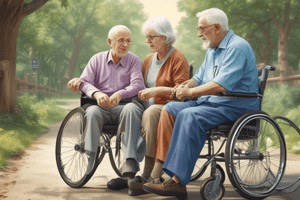Podcast
Questions and Answers
What is the primary characteristic of a septic joint infection?
What is the primary characteristic of a septic joint infection?
- Joint shows no signs of inflammation
- Joint is red, warm, swollen, and tender (correct)
- Joint exhibits mild swelling and stiffness
- Movement of the joint is completely normal
Which test is used to assess the presence of shoulder impingement?
Which test is used to assess the presence of shoulder impingement?
- Straight Leg Raise Test
- McMurray's Test
- Hawkin's impingement sign (correct)
- Femoral Stretch Test
In the context of gout, what is a significant diagnostic indicator?
In the context of gout, what is a significant diagnostic indicator?
- Normal X-ray findings
- Consistent joint tenderness only during rest
- Joint pain exclusively in the hip
- Presence of tophi and joint fluid showing crystals (correct)
Which condition is characterized by joint findings resembling rheumatoid arthritis in its chronic phase?
Which condition is characterized by joint findings resembling rheumatoid arthritis in its chronic phase?
What underlying factor increases the likelihood of infecting a joint?
What underlying factor increases the likelihood of infecting a joint?
What developmental challenge may be suggested by the persistence of the Glabellar Reflex in older children?
What developmental challenge may be suggested by the persistence of the Glabellar Reflex in older children?
Which of the following is characteristic of Still's murmur?
Which of the following is characteristic of Still's murmur?
At what age should the Asymmetric Tonic Neck Reflex typically disappear?
At what age should the Asymmetric Tonic Neck Reflex typically disappear?
Which of the following describes central cyanosis?
Which of the following describes central cyanosis?
What is a significant indicator of respiratory distress based on physical examination findings?
What is a significant indicator of respiratory distress based on physical examination findings?
When examining a child's growth, which trend is noted to occur by age 1 regarding weight?
When examining a child's growth, which trend is noted to occur by age 1 regarding weight?
Which of the following findings is most concerning for pathology when found during an eye examination?
Which of the following findings is most concerning for pathology when found during an eye examination?
What growth trend regarding head circumference occurs after the first year of life?
What growth trend regarding head circumference occurs after the first year of life?
What is the primary benefit of early identification of congenital anomalies in newborn assessment?
What is the primary benefit of early identification of congenital anomalies in newborn assessment?
Which of the following is NOT a key aspect of pediatric care for parents during follow-up visits?
Which of the following is NOT a key aspect of pediatric care for parents during follow-up visits?
In assessing a pediatric patient, why is it important to adapt the examination approach based on the child's developmental stage?
In assessing a pediatric patient, why is it important to adapt the examination approach based on the child's developmental stage?
The Denver II Developmental Assessment is primarily used to screen for which of the following areas?
The Denver II Developmental Assessment is primarily used to screen for which of the following areas?
Which of the following components is essential when taking a pediatric history?
Which of the following components is essential when taking a pediatric history?
During a physical examination of an infant, where is it generally preferable to perform the examination?
During a physical examination of an infant, where is it generally preferable to perform the examination?
What does BMI percentiles indicate in pediatric patients?
What does BMI percentiles indicate in pediatric patients?
For which reason is observing child-parent interactions important during a pediatric examination?
For which reason is observing child-parent interactions important during a pediatric examination?
What is the recommended screening age for colon cancer in adults without high-risk factors?
What is the recommended screening age for colon cancer in adults without high-risk factors?
How often should women aged 30-65 receive co-testing for cervical cancer?
How often should women aged 30-65 receive co-testing for cervical cancer?
Which population is at increased risk for Mental Health issues according to health disparities?
Which population is at increased risk for Mental Health issues according to health disparities?
What is the recommended frequency of DEXA scans for postmenopausal women with low bone density?
What is the recommended frequency of DEXA scans for postmenopausal women with low bone density?
Men aged 55-69 are advised to undergo which type of testing for prostate cancer?
Men aged 55-69 are advised to undergo which type of testing for prostate cancer?
What screening is recommended annually for adults aged 50-80 with a history of heavy smoking?
What screening is recommended annually for adults aged 50-80 with a history of heavy smoking?
Which health risk is particularly heightened among sexual minority women due to healthcare avoidance?
Which health risk is particularly heightened among sexual minority women due to healthcare avoidance?
What is the primary principle of patient-centered care in LGBTQI health promotion?
What is the primary principle of patient-centered care in LGBTQI health promotion?
What is the significance of a score between 8 and 10 on the Apgar scoring system?
What is the significance of a score between 8 and 10 on the Apgar scoring system?
Which reflex is characterized by a newborn's startle response where arms extend and are then brought together?
Which reflex is characterized by a newborn's startle response where arms extend and are then brought together?
What does a positive Ortolani test indicate in a newborn?
What does a positive Ortolani test indicate in a newborn?
How is gestational age assessed in newborns using the Ballard scoring system?
How is gestational age assessed in newborns using the Ballard scoring system?
What is the primary purpose of the Barlow test in newborn assessment?
What is the primary purpose of the Barlow test in newborn assessment?
Which treatment is often required for severe hyperbilirubinemia to prevent kernicterus?
Which treatment is often required for severe hyperbilirubinemia to prevent kernicterus?
What physiological mechanism primarily causes physiologic hyperbilirubinemia in newborns?
What physiological mechanism primarily causes physiologic hyperbilirubinemia in newborns?
What does the presence of a positive Barlow test suggest about the hip status of a newborn?
What does the presence of a positive Barlow test suggest about the hip status of a newborn?
Which factor is NOT considered a parental risk factor for childhood abuse and neglect?
Which factor is NOT considered a parental risk factor for childhood abuse and neglect?
What type of abuse involves children participating in activities they cannot consent to or understand?
What type of abuse involves children participating in activities they cannot consent to or understand?
Which of the following is a common challenge in engaging adolescents in discussions about their health?
Which of the following is a common challenge in engaging adolescents in discussions about their health?
Which sign is considered a pathognomonic injury commonly associated with physical abuse?
Which sign is considered a pathognomonic injury commonly associated with physical abuse?
What is an example of emotional abuse that is particularly difficult to measure?
What is an example of emotional abuse that is particularly difficult to measure?
Which type of neglect is often correlated with the term 'failure to thrive'?
Which type of neglect is often correlated with the term 'failure to thrive'?
Which of the following child factors increases the risk for childhood abuse and neglect?
Which of the following child factors increases the risk for childhood abuse and neglect?
What approach is recommended for building trust with adolescents during healthcare discussions?
What approach is recommended for building trust with adolescents during healthcare discussions?
Flashcards
Colon Cancer Screening Age
Colon Cancer Screening Age
Adults aged 45-75 should get a colonoscopy every 10 years. Those with a family history or inflammatory bowel disease should be screened earlier.
Breast Cancer Screening
Breast Cancer Screening
Women aged 40-74 should get mammograms. Starting at age 50, biennial mammograms are recommended.
Lung Cancer Screening
Lung Cancer Screening
Adults aged 50-80 with a history of heavy smoking should get an annual low-dose CT scan. This applies to those who currently smoke or quit within the past 15 years.
Osteoporosis Screening
Osteoporosis Screening
Signup and view all the flashcards
LGBTQI Mental Health Concerns
LGBTQI Mental Health Concerns
Signup and view all the flashcards
LGBTQI Substance Use
LGBTQI Substance Use
Signup and view all the flashcards
LGBTQI STI & HIV Risk
LGBTQI STI & HIV Risk
Signup and view all the flashcards
LGBTQI Patient-Centered Care
LGBTQI Patient-Centered Care
Signup and view all the flashcards
Timing in newborn assessment
Timing in newborn assessment
Signup and view all the flashcards
Pediatrician's role
Pediatrician's role
Signup and view all the flashcards
NSVD
NSVD
Signup and view all the flashcards
BMI Percentiles
BMI Percentiles
Signup and view all the flashcards
Developmental Milestones
Developmental Milestones
Signup and view all the flashcards
Denver II Developmental Assessment
Denver II Developmental Assessment
Signup and view all the flashcards
Approaching a pediatric patient
Approaching a pediatric patient
Signup and view all the flashcards
Birth history
Birth history
Signup and view all the flashcards
Vital Signs (Pediatrics)
Vital Signs (Pediatrics)
Signup and view all the flashcards
Growth Parameters
Growth Parameters
Signup and view all the flashcards
Glabellar Reflex
Glabellar Reflex
Signup and view all the flashcards
Asymmetric Tonic Neck Reflex (ATNR)
Asymmetric Tonic Neck Reflex (ATNR)
Signup and view all the flashcards
Cyanosis
Cyanosis
Signup and view all the flashcards
Retractions
Retractions
Signup and view all the flashcards
Still's Murmur
Still's Murmur
Signup and view all the flashcards
Newborn Assessment Techniques
Newborn Assessment Techniques
Signup and view all the flashcards
APGAR Score
APGAR Score
Signup and view all the flashcards
Ballard Scoring System
Ballard Scoring System
Signup and view all the flashcards
Barlow Test
Barlow Test
Signup and view all the flashcards
Ortolani Test
Ortolani Test
Signup and view all the flashcards
Moro Reflex
Moro Reflex
Signup and view all the flashcards
Hyperbilirubinemia
Hyperbilirubinemia
Signup and view all the flashcards
Causes of Hyperbilirubinemia
Causes of Hyperbilirubinemia
Signup and view all the flashcards
Strength-Based Interviewing Approach
Strength-Based Interviewing Approach
Signup and view all the flashcards
Challenges in Adolescent Encounters
Challenges in Adolescent Encounters
Signup and view all the flashcards
Goals in Adolescent Encounters
Goals in Adolescent Encounters
Signup and view all the flashcards
Physical Abuse
Physical Abuse
Signup and view all the flashcards
Sexual Abuse
Sexual Abuse
Signup and view all the flashcards
Neglect
Neglect
Signup and view all the flashcards
Emotional Abuse
Emotional Abuse
Signup and view all the flashcards
Signs of Physical Abuse
Signs of Physical Abuse
Signup and view all the flashcards
Septic Arthritis
Septic Arthritis
Signup and view all the flashcards
Gout
Gout
Signup and view all the flashcards
CPPD (Pseudogout)
CPPD (Pseudogout)
Signup and view all the flashcards
Spurling's Maneuver
Spurling's Maneuver
Signup and view all the flashcards
Hawkin's Impingement Sign
Hawkin's Impingement Sign
Signup and view all the flashcards
Study Notes
Geriatric Medicine Study Notes
-
Dementia vs. Delirium: Dementia is a chronic, progressive decline in cognitive function, including memory loss and impaired reasoning. Delirium is an acute, reversible state of confusion, often caused by an underlying medical condition.
-
Dementia Assessment: Tools like the Mini-Mental State Examination (MMSE) and the Montreal Cognitive Assessment (MoCA) are used to evaluate cognitive function.
-
Delirium Triggers: Infections (e.g., UTI, pneumonia), electrolyte imbalances, medications, dehydration, and surgery are common triggers of delirium.
-
Geriatric Medical Concerns: Incontinence, insomnia, loss of function, depression, diet concerns, and mobility issues are common medical concerns affecting quality of life.
-
Improving Quality of Life: Physical therapy, occupational therapy, assistive devices, medication management, and nutritional counseling are used to improve quality of life for the elderly.
-
Medication Risks: Polypharmacy (taking multiple medications), polyprovider (being under care of many doctors), and inadequate medication management are risks for elderly patients.
LGBTQI Health Considerations
-
Mental Health: LGBTQI populations face higher rates of depression, anxiety, suicidal behavior, and eating disorders.
-
Substance Use: Increased tobacco, alcohol, and drug use are often observed in these populations as coping mechanisms.
-
STIs and HIV: MSM (men who have sex with men) and trans women are disproportionately affected by HIV and other STIs.
-
Cardiovascular Risks: Smoking, obesity, and disordered eating contribute to increased cardiovascular risks.
-
Violence and Trauma: LGBTQIA+ individuals experience elevated rates of hate crimes, sexual assault, and intimate partner violence.
Immunizations and Screening
-
Tdap: A single dose is recommended for adults if not previously received; boosters every 10 years.
-
Influenza Vaccine: Recommended annually for all adults. High-dose or adjuvanted vaccines are recommended for those aged 65+.
-
Pneumococcal Vaccines: Required for adults aged 65+ or younger with specific risk factors.
-
Zoster Vaccine: Two doses, 2-6 months apart, starting at age 50.
-
Hepatitis A & B: Two or three doses are recommended for adults at risk.
-
Colon Cancer: Annual screening (colonoscopy) is advised for adults ages 45-75 (or earlier for family history).
-
Breast Cancer: Biennial mammograms are recommended for women ages 40-74, starting at or before 50.
-
Lung Cancer: Annual low-dose CT (LDCT) screening is recommended for adults aged 50-80 with a history of heavy smoking.
-
Osteoporosis: DEXA scans are used for risk assessment of osteoporosis.
-
Cervical Cancer: Women aged 21-69 receive Pap smears.
Newborn Assessment
-
Recognize Terminology: Meconium, SGA, AGA, LGA, vernix, fontanelle, molding, perioral cyanosis, acrocyanosis, milia.
-
Goals of Assessment: Identify anomalies, reassure parents, determine health status, and plan appropriate action.
-
Physical Examination: Observation (positioning, tone, color). Cardiorespiratory (rate, rhythms, distress). Abdomen (masses). Extremities (digits, hips). Neuro -reflexes, tone and responsiveness).
Adolescent Medicine
-
Tanner Stages: Used to track physical development in adolescents.
-
Confidentiality and Informed Consent: Maintain confidentiality but recognize situations where a report to authorities is required.
-
Concerns: Establishing confidentiality to discuss sensitive issues like risky sexual behaviors, substance use, and mental health.
Child Abuse and Neglect
-
Parental Factors: Substance abuse, mental illness, and inexperience are risk factors.
-
Child Factors: Behaviours like ADHD, chronic medical issues, and being unwanted.
-
Environmental Factors: Poverty, lack of social support, domestic violence, and large family sizes.
-
Recognizing Abuse: Recognizing physical and behavioural indicators.
Rheumatologic Diseases
-
Localized/Systemic: Identifying if the condition is confined to specific joint regions or spreading to other systems.
-
Articular/Non-Articular: Determining if the condition affects the joints directly.
-
Inflammatory/Non-inflammatory: Determining the underlying cause of inflammation in the joints
Studying That Suits You
Use AI to generate personalized quizzes and flashcards to suit your learning preferences.





